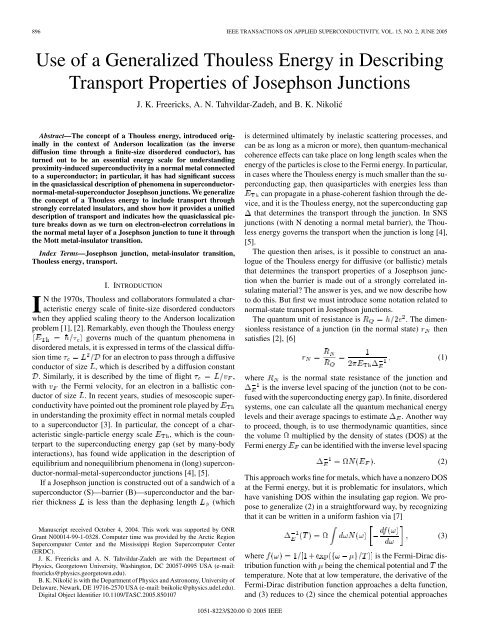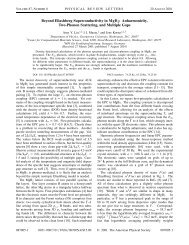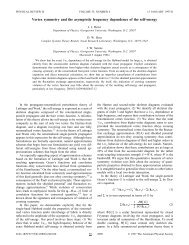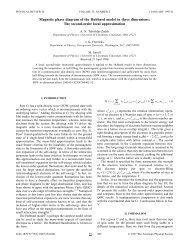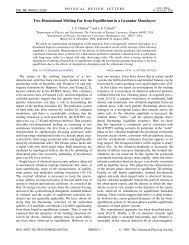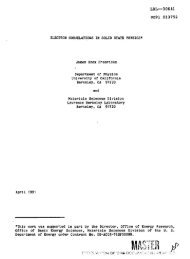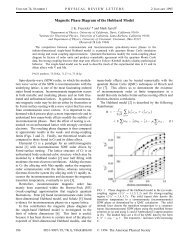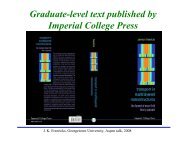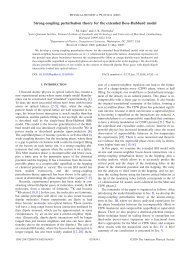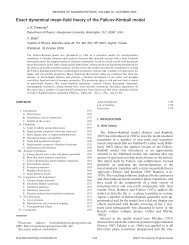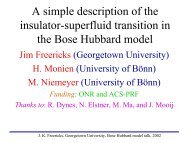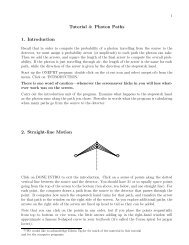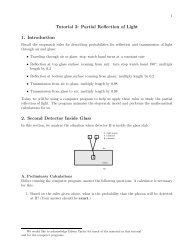Use of a Generalized Thouless Energy in Describing ... - IEEE Xplore
Use of a Generalized Thouless Energy in Describing ... - IEEE Xplore
Use of a Generalized Thouless Energy in Describing ... - IEEE Xplore
Create successful ePaper yourself
Turn your PDF publications into a flip-book with our unique Google optimized e-Paper software.
896 <strong>IEEE</strong> TRANSACTIONS ON APPLIED SUPERCONDUCTIVITY, VOL. 15, NO. 2, JUNE 2005<br />
<strong>Use</strong> <strong>of</strong> a <strong>Generalized</strong> <strong>Thouless</strong> <strong>Energy</strong> <strong>in</strong> Describ<strong>in</strong>g<br />
Transport Properties <strong>of</strong> Josephson Junctions<br />
J. K. Freericks, A. N. Tahvildar-Zadeh, and B. K. Nikolić<br />
Abstract—The concept <strong>of</strong> a <strong>Thouless</strong> energy, <strong>in</strong>troduced orig<strong>in</strong>ally<br />
<strong>in</strong> the context <strong>of</strong> Anderson localization (as the <strong>in</strong>verse<br />
diffusion time through a f<strong>in</strong>ite-size disordered conductor), has<br />
turned out to be an essential energy scale for understand<strong>in</strong>g<br />
proximity-<strong>in</strong>duced superconductivity <strong>in</strong> a normal metal connected<br />
to a superconductor; <strong>in</strong> particular, it has had significant success<br />
<strong>in</strong> the quasiclassical description <strong>of</strong> phenomena <strong>in</strong> superconductornormal-metal-superconductor<br />
Josephson junctions. We generalize<br />
the concept <strong>of</strong> a <strong>Thouless</strong> energy to <strong>in</strong>clude transport through<br />
strongly correlated <strong>in</strong>sulators, and show how it provides a unified<br />
description <strong>of</strong> transport and <strong>in</strong>dicates how the quasiclassical picture<br />
breaks down as we turn on electron-electron correlations <strong>in</strong><br />
the normal metal layer <strong>of</strong> a Josephson junction to tune it through<br />
the Mott metal-<strong>in</strong>sulator transition.<br />
Index Terms—Josephson junction, metal-<strong>in</strong>sulator transition,<br />
<strong>Thouless</strong> energy, transport.<br />
I. INTRODUCTION<br />
IN the 1970s, <strong>Thouless</strong> and collaborators formulated a characteristic<br />
energy scale <strong>of</strong> f<strong>in</strong>ite-size disordered conductors<br />
when they applied scal<strong>in</strong>g theory to the Anderson localization<br />
problem [1], [2]. Remarkably, even though the <strong>Thouless</strong> energy<br />
governs much <strong>of</strong> the quantum phenomena <strong>in</strong><br />
disordered metals, it is expressed <strong>in</strong> terms <strong>of</strong> the classical diffusion<br />
time<br />
for an electron to pass through a diffusive<br />
conductor <strong>of</strong> size , which is described by a diffusion constant<br />
. Similarly, it is described by the time <strong>of</strong> flight ,<br />
with the Fermi velocity, for an electron <strong>in</strong> a ballistic conductor<br />
<strong>of</strong> size . In recent years, studies <strong>of</strong> mesoscopic superconductivity<br />
have po<strong>in</strong>ted out the prom<strong>in</strong>ent role played by<br />
<strong>in</strong> understand<strong>in</strong>g the proximity effect <strong>in</strong> normal metals coupled<br />
to a superconductor [3]. In particular, the concept <strong>of</strong> a characteristic<br />
s<strong>in</strong>gle-particle energy scale , which is the counterpart<br />
to the superconduct<strong>in</strong>g energy gap (set by many-body<br />
<strong>in</strong>teractions), has found wide application <strong>in</strong> the description <strong>of</strong><br />
equilibrium and nonequilibrium phenomena <strong>in</strong> (long) superconductor-normal-metal-superconductor<br />
junctions [4], [5].<br />
If a Josephson junction is constructed out <strong>of</strong> a sandwich <strong>of</strong> a<br />
superconductor (S)—barrier (B)—superconductor and the barrier<br />
thickness is less than the dephas<strong>in</strong>g length (which<br />
Manuscript received October 4, 2004. This work was supported by ONR<br />
Grant N00014-99-1-0328. Computer time was provided by the Arctic Region<br />
Supercomputer Center and the Mississippi Region Supercomputer Center<br />
(ERDC).<br />
J. K. Freericks and A. N. Tahvildar-Zadeh are with the Department <strong>of</strong><br />
Physics, Georgetown University, Wash<strong>in</strong>gton, DC 20057-0995 USA (e-mail:<br />
freericks@physics.georgetown.edu).<br />
B. K. Nikolić is with the Department <strong>of</strong> Physics and Astronomy, University <strong>of</strong><br />
Delaware, Newark, DE 19716-2570 USA (e-mail: bnikolic@physics.udel.edu).<br />
Digital Object Identifier 10.1109/TASC.2005.850107<br />
is determ<strong>in</strong>ed ultimately by <strong>in</strong>elastic scatter<strong>in</strong>g processes, and<br />
can be as long as a micron or more), then quantum-mechanical<br />
coherence effects can take place on long length scales when the<br />
energy <strong>of</strong> the particles is close to the Fermi energy. In particular,<br />
<strong>in</strong> cases where the <strong>Thouless</strong> energy is much smaller than the superconduct<strong>in</strong>g<br />
gap, then quasiparticles with energies less than<br />
can propagate <strong>in</strong> a phase-coherent fashion through the device,<br />
and it is the <strong>Thouless</strong> energy, not the superconduct<strong>in</strong>g gap<br />
that determ<strong>in</strong>es the transport through the junction. In SNS<br />
junctions (with N denot<strong>in</strong>g a normal metal barrier), the <strong>Thouless</strong><br />
energy governs the transport when the junction is long [4],<br />
[5].<br />
The question then arises, is it possible to construct an analogue<br />
<strong>of</strong> the <strong>Thouless</strong> energy for diffusive (or ballistic) metals<br />
that determ<strong>in</strong>es the transport properties <strong>of</strong> a Josephson junction<br />
when the barrier is made out <strong>of</strong> a strongly correlated <strong>in</strong>sulat<strong>in</strong>g<br />
material? The answer is yes, and we now describe how<br />
to do this. But first we must <strong>in</strong>troduce some notation related to<br />
normal-state transport <strong>in</strong> Josephson junctions.<br />
The quantum unit <strong>of</strong> resistance is<br />
. The dimensionless<br />
resistance <strong>of</strong> a junction (<strong>in</strong> the normal state) then<br />
satisfies [2], [6]<br />
where is the normal state resistance <strong>of</strong> the junction and<br />
is the <strong>in</strong>verse level spac<strong>in</strong>g <strong>of</strong> the junction (not to be confused<br />
with the superconduct<strong>in</strong>g energy gap). In f<strong>in</strong>ite, disordered<br />
systems, one can calculate all the quantum mechanical energy<br />
levels and their average spac<strong>in</strong>gs to estimate . Another way<br />
to proceed, though, is to use thermodynamic quantities, s<strong>in</strong>ce<br />
the volume multiplied by the density <strong>of</strong> states (DOS) at the<br />
Fermi energy can be identified with the <strong>in</strong>verse level spac<strong>in</strong>g<br />
This approach works f<strong>in</strong>e for metals, which have a nonzero DOS<br />
at the Fermi energy, but it is problematic for <strong>in</strong>sulators, which<br />
have vanish<strong>in</strong>g DOS with<strong>in</strong> the <strong>in</strong>sulat<strong>in</strong>g gap region. We propose<br />
to generalize (2) <strong>in</strong> a straightforward way, by recogniz<strong>in</strong>g<br />
that it can be written <strong>in</strong> a uniform fashion via [7]<br />
where<br />
is the Fermi-Dirac distribution<br />
function with be<strong>in</strong>g the chemical potential and the<br />
temperature. Note that at low temperature, the derivative <strong>of</strong> the<br />
Fermi-Dirac distribution function approaches a delta function,<br />
and (3) reduces to (2) s<strong>in</strong>ce the chemical potential approaches<br />
(1)<br />
(2)<br />
(3)<br />
1051-8223/$20.00 © 2005 <strong>IEEE</strong>
FREERICKS et al.: THOULESS ENERGY IN DESCRIBING TRANSPORT PROPERTIES OF JOSEPHSON JUNCTIONS 897<br />
as . However, <strong>in</strong> an <strong>in</strong>sulator the <strong>in</strong>tegral has strong<br />
temperature dependence, so this generalization <strong>of</strong> the <strong>in</strong>verse<br />
level spac<strong>in</strong>g depends strongly on temperature.<br />
Our strategy here is to <strong>in</strong>vert the conventional logic, and not<br />
th<strong>in</strong>k <strong>of</strong> the resistance as the ratio <strong>of</strong> the level spac<strong>in</strong>g to the<br />
<strong>Thouless</strong> energy, but rather th<strong>in</strong>k <strong>of</strong> the <strong>Thouless</strong> energy as an<br />
energy scale extracted from the resistance and the <strong>in</strong>verse level<br />
spac<strong>in</strong>g <strong>of</strong> the barrier. The key requirement for this heuristic<br />
approach is the ability to compute (or measure) the two-probe<br />
resistance <strong>of</strong> a f<strong>in</strong>ite thickness <strong>of</strong> a strongly correlated material<br />
that is sandwiched between two ballistic semi-<strong>in</strong>f<strong>in</strong>ite leads [7],<br />
[8]. Hence we def<strong>in</strong>e the (temperature-dependent) <strong>Thouless</strong> energy<br />
to be<br />
(4)<br />
where is the cross-sectional area <strong>of</strong> the device, and is<br />
the thickness <strong>of</strong> the scatter<strong>in</strong>g region. Equation (4) provides<br />
an operational def<strong>in</strong>ition <strong>of</strong> the <strong>Thouless</strong> energy that can be<br />
directly measured for a device by measur<strong>in</strong>g the dependence<br />
<strong>of</strong> the normal-state resistance on temperature, and evaluat<strong>in</strong>g<br />
the relevant <strong>in</strong>tegral us<strong>in</strong>g the bulk DOS for the material that is<br />
employed as the barrier. This procedure is not normally carried<br />
out by experimentalists, but we th<strong>in</strong>k it can be quite helpful <strong>in</strong><br />
understand<strong>in</strong>g properties <strong>of</strong> the Josephson junction and <strong>of</strong> the<br />
normal state transport. Note that (4) not only agrees with all <strong>of</strong><br />
the conventional def<strong>in</strong>itions <strong>of</strong> the <strong>Thouless</strong> energy for diffusive<br />
and ballistic systems, but also provides a unify<strong>in</strong>g picture that<br />
treats both known cases with the same expression and can also<br />
treat <strong>in</strong>sulators. In this sense, we do not need to determ<strong>in</strong>e<br />
the type <strong>of</strong> transport before employ<strong>in</strong>g (4), <strong>in</strong>stead, we can<br />
determ<strong>in</strong>e the <strong>Thouless</strong> energy directly from a measurement <strong>of</strong><br />
the resistance.<br />
II. NUMERICAL ANALYSIS<br />
Our work will focus on numerical simulations <strong>of</strong> multilayered<br />
nanostructures that represent the Josephson junction. We stack<br />
<strong>in</strong>f<strong>in</strong>ite two-dimensional planes <strong>in</strong> the -direction. The planes<br />
to the left are made <strong>of</strong> a ballistic superconductor, as are those to<br />
the right. In the middle, we have the planes <strong>of</strong> the barrier, which<br />
we describe by a Falicov-Kimball (FK) [9] model, which can<br />
be thought <strong>of</strong> as non<strong>in</strong>teract<strong>in</strong>g band electrons that <strong>in</strong>teract with<br />
charge scatter<strong>in</strong>g centers with a strength . Such a system<br />
can be realized by a b<strong>in</strong>ary alloy, that has the same hopp<strong>in</strong>g <strong>in</strong>tegral<br />
between different species, but a different site energy (the<br />
difference equals ). The Falicov Kimball model has a metal<br />
<strong>in</strong>sulator transition as a function <strong>of</strong> , which allows us to<br />
tune the metallicity <strong>of</strong> the barrier from a ballistic metal to a Mott<br />
<strong>in</strong>sulator. We choose to have on average one scatter<strong>in</strong>g center<br />
for every other site <strong>in</strong> the barrier planes, hence it corresponds<br />
to a 50%-50% b<strong>in</strong>ary alloy system. In the <strong>in</strong>sulat<strong>in</strong>g phase, the<br />
properties don’t depend too strongly on the details <strong>of</strong> the <strong>in</strong>sulator,<br />
so our model will be able to provide generic results for<br />
many systems. Note that we have chosen to match the chemical<br />
potentials <strong>in</strong> the superconductor and <strong>in</strong> the barrier, so there is<br />
no charge rearrangement at the <strong>in</strong>terfaces, and no Schottky-like<br />
barriers.<br />
Fig. 1. Schematic <strong>of</strong> the multilayered nanostructure represent<strong>in</strong>g the<br />
Josephson junction. The metal planes <strong>of</strong> the lead are superconduct<strong>in</strong>g,<br />
while the barrier planes are described by the Falicov-Kimball model. In our<br />
calculations we actually use 30 metallic lead planes on the right and the left <strong>of</strong><br />
the barrier before connect<strong>in</strong>g them to their respective semi-<strong>in</strong>f<strong>in</strong>ite leads.<br />
The Hamiltonian is then [9]<br />
The lattice sites are those <strong>of</strong> a simple cubic lattice (with lattice<br />
constant ), and we choose the nearest-neighbor hopp<strong>in</strong>g<br />
to be the same with<strong>in</strong> the planes and between the planes; we<br />
also choose the hopp<strong>in</strong>g to be the same <strong>in</strong> the superconductor as<br />
<strong>in</strong> the barrier (see Fig. 1). This hopp<strong>in</strong>g energy will be used as<br />
our energy scale. The superconductor is described by an attractive<br />
Hubbard model [10] (with <strong>in</strong>teraction strength )<strong>in</strong><br />
mean field theory, which is equivalent to a BCS superconductor,<br />
but with the energy cut<strong>of</strong>f determ<strong>in</strong>ed by the band structure<br />
rather than the phonon frequency. The superconduct<strong>in</strong>g transition<br />
temperature is<br />
and the superconduct<strong>in</strong>g gap at<br />
zero temperature is<br />
[11], [12]. The barrier planes<br />
are described by the Falicov-Kimball model, with an average<br />
concentration <strong>of</strong> scatter<strong>in</strong>g centers equal to 1/2, and the<br />
classical variable is one when an atom is at site and zero<br />
when a atom is at site . The Hubbard <strong>in</strong>teraction is chosen to<br />
vanish <strong>in</strong> the barrier region.<br />
Our calculations use an <strong>in</strong>homogeneous version <strong>of</strong> dynamical<br />
mean field theory <strong>in</strong> both the normal [13] and the<br />
superconduct<strong>in</strong>g [11], [12] states to calculate and (the<br />
critical current <strong>of</strong> the Josephson junction). The details <strong>of</strong> this<br />
computational scheme are given elsewhere [11], [12]; this technique<br />
is a self-consistent recursive Green’s function approach<br />
that becomes exact as the coord<strong>in</strong>ation number <strong>of</strong> the lattice<br />
<strong>in</strong>creases to <strong>in</strong>f<strong>in</strong>ity—it is expected to be quite accurate <strong>in</strong> three<br />
dimensions.<br />
In the bulk, the FK model has a metal-<strong>in</strong>sulator transition on<br />
a cubic lattice when<br />
. The transition is cont<strong>in</strong>uous,<br />
so the mean free path decreases from when ,<br />
(5)
898 <strong>IEEE</strong> TRANSACTIONS ON APPLIED SUPERCONDUCTIVITY, VOL. 15, NO. 2, JUNE 2005<br />
Fig. 2.<br />
<strong>Thouless</strong> energy (<strong>in</strong> units <strong>of</strong> the superconduct<strong>in</strong>g gap) versus<br />
temperature for (a) U =4, (b) U =5, and (c) U =6. The different<br />
curves correspond to different thicknesses the barrier; from top to bottom they<br />
are: panel (a) L=a =1, 2, 5, 10, 15, 20, 30, 40, 60, and 80; panel (b) L=a =1,<br />
2, 3, 4, 5, 7, 10, 15, 20, 30; and <strong>in</strong> panel (c) L=a =1,2,3,4,5,7,10,15,<br />
and 20. Note how the temperature dependence <strong>in</strong>creases as the barrier becomes<br />
more <strong>in</strong>sulat<strong>in</strong>g. The dashed l<strong>in</strong>e <strong>in</strong> the bottom two panels is the l<strong>in</strong>e E = T .<br />
to when ,to when (and<br />
). The I<strong>of</strong>fe-Regel limit [14] is reached when the mean<br />
free path <strong>of</strong> the electrons approaches one lattice spac<strong>in</strong>g, so that<br />
a Boltzmann equation approach is no longer applicable; <strong>in</strong> the<br />
FK model, it occurs around , but the system rema<strong>in</strong>s<br />
metallic until<br />
where it has a transition to an <strong>in</strong>sulator.<br />
While one would not expect a diffusive model for transport<br />
(with a Boltzmann equation) to hold for larger than<br />
about 2, we f<strong>in</strong>d no significant difference <strong>in</strong> the properties <strong>of</strong><br />
the transport <strong>in</strong> this regime, with the exception <strong>of</strong> an anomalous<br />
temperature dependence <strong>of</strong> the resistivity as the metal-<strong>in</strong>sulator<br />
transition is approached. In other words, the system behaves like<br />
a diffusive metal, but with a temperature dependent diffusion<br />
constant as the metal-<strong>in</strong>sulator transition is approached.<br />
We calculate the normal-state resistance <strong>of</strong> our Josephson<br />
junctions by us<strong>in</strong>g a Kubo formula [7], [8], [15], [16], for the<br />
conductivity matrix <strong>in</strong> real space, and employ Ohm’s law (<strong>in</strong> the<br />
form ) to extract the resistance from the real-space conductivity<br />
matrix. %(this approach requires us to use current conservation<br />
for the current %flow<strong>in</strong>g from one plane to its neighbor<strong>in</strong>g<br />
plane). The normal-state resistance behaves as expected<br />
for these junctions [7]: <strong>in</strong> the metallic phase, we have an Ohmic<br />
scal<strong>in</strong>g, with the resistance equal to a Sharv<strong>in</strong> contact resistance<br />
[17], [18] plus a contribution <strong>of</strong> com<strong>in</strong>g from the “bulk”<br />
<strong>of</strong> the barrier, where is the bulk dc resistivity <strong>of</strong> the barrier.<br />
In an <strong>in</strong>sulator, we f<strong>in</strong>d that at low temperature, or for th<strong>in</strong> barriers,<br />
the system transports current via tunnel<strong>in</strong>g, which has an<br />
exponential growth <strong>of</strong> the resistance with . Once the junction<br />
is thick enough, or is high enough, the transport is dom<strong>in</strong>ated<br />
Fig. 3. Dependence <strong>of</strong> the figure <strong>of</strong> merit on the generalized <strong>Thouless</strong> energy<br />
<strong>in</strong> units <strong>of</strong> the superconduct<strong>in</strong>g gap. Five cases are <strong>in</strong>cluded <strong>in</strong> the simulations:<br />
(i) a ballistic SNS junction (U =0); (ii) a diffusive SNS junction close to<br />
the I<strong>of</strong>fe-Regel limit (U =2); (iii) a diffusive SNS junction well beyond the<br />
I<strong>of</strong>fe-Regel limit (U =4); (iv) a Mott <strong>in</strong>sulat<strong>in</strong>g barrier close to the critical<br />
value <strong>of</strong> U (U =5); and a (v) small-gap Mott <strong>in</strong>sulator (U =6). The<br />
solid l<strong>in</strong>e is the quasiclassical approximation for diffusive SNS junctions, and<br />
the cha<strong>in</strong>-dashed l<strong>in</strong>e is a simple exponential form, expected for a ballistic SNS<br />
junction. Panel (a) is a blow-up <strong>of</strong> the full plot shown <strong>in</strong> panel (b).<br />
by thermally excited quasiparticles, and it picks up an Ohmic<br />
scal<strong>in</strong>g with the bulk resistivity (which is now strongly dependent).<br />
The normal state resistance, and the density <strong>of</strong> states<br />
for the bulk barrier are all that we need to determ<strong>in</strong>e the <strong>Thouless</strong><br />
energy. We plot this for three cases , 5, and 6 <strong>in</strong><br />
Fig. 2. The different curves correspond to different thicknesses<br />
<strong>of</strong> the barrier. Note how the <strong>Thouless</strong> energy has little temperature<br />
dependence <strong>in</strong> the anomalous metal<br />
, but it<br />
picks up stronger dependence as we pass <strong>in</strong>to the <strong>in</strong>sulator,<br />
near the critical coupl<strong>in</strong>g , and <strong>in</strong> a small-gap <strong>in</strong>sulator<br />
. In the (diffusive) metallic phase, we f<strong>in</strong>d<br />
scales like for thick junctions, as expected. In the <strong>in</strong>sulat<strong>in</strong>g<br />
phases, it was found that the po<strong>in</strong>t where the temperature<br />
was equal to determ<strong>in</strong>ed the approximate crossover<br />
from tunnel<strong>in</strong>g to <strong>in</strong>coherent transport [7]. Here we will exam<strong>in</strong>e<br />
what happens to a Josephson junction as a function <strong>of</strong><br />
the <strong>Thouless</strong> energy.<br />
In Fig. 3, we plot the figure-<strong>of</strong>-merit divided by the superconduct<strong>in</strong>g<br />
gap versus the <strong>Thouless</strong> energy divided<br />
by the superconduct<strong>in</strong>g gap<br />
for a low temperature<br />
. Five different cases are <strong>in</strong>cluded: (i) a ballistic<br />
metal SNS junction ; (ii) a diffusive metal close<br />
to the I<strong>of</strong>fe-Regel limit ; (iii) an anomalous metal<br />
close to the metal-<strong>in</strong>sulator transition (the dotted l<strong>in</strong>e<br />
is a guide to the eye); (iv) an <strong>in</strong>sulator close to the critical po<strong>in</strong>t<br />
<strong>of</strong> the metal-<strong>in</strong>sulator transition ; and (v) a small gap<br />
correlated <strong>in</strong>sulator . In addition to the data that we<br />
calculated directly with our DMFT-based computer codes, we
FREERICKS et al.: THOULESS ENERGY IN DESCRIBING TRANSPORT PROPERTIES OF JOSEPHSON JUNCTIONS 899<br />
<strong>in</strong>clude two analytical expressions. The cha<strong>in</strong>-dashed l<strong>in</strong>e is the<br />
prediction for a ballistic SNS junction, where the critical current<br />
decreases exponentially with thickness, and the resistance is just<br />
the Sharv<strong>in</strong> resistance, and is <strong>in</strong>dependent <strong>of</strong> . The solid l<strong>in</strong>e<br />
is the prediction <strong>of</strong> the quasiclassical theory [4], [5], modified<br />
for f<strong>in</strong>ite temperature. We used the analytic result<br />
for small and then jo<strong>in</strong>ed it to the results for larger<br />
.<br />
The results <strong>in</strong> Fig. 3 are the ma<strong>in</strong> results <strong>of</strong> this work. They<br />
show that all diffusive metals, <strong>in</strong>clud<strong>in</strong>g those with mean free<br />
paths much less than a lattice spac<strong>in</strong>g, obey the quasiclassical<br />
predictions. When the barrier is tuned through the metal<strong>in</strong>sulator<br />
transition (solid circles and stars), the results are still<br />
qualitatively similar to those <strong>of</strong> the quasiclassical approach,<br />
but the figure-<strong>of</strong>-merit is smaller for large , and then<br />
crosses over (at about<br />
) and becomes larger for<br />
small . Hence there is a weaker dependence on <strong>in</strong> the<br />
<strong>in</strong>sulat<strong>in</strong>g cases, although the dependence is still quite a strong<br />
function <strong>of</strong> (recall Fig. 3 is a log-log plot). This is how the<br />
quasiclassical picture breaks down <strong>in</strong> a Josephson junction.<br />
III. CONCLUSIONS<br />
We have demonstrated that the concept <strong>of</strong> a <strong>Thouless</strong> energy<br />
can be generalized to strongly correlated metals and strongly<br />
correlated <strong>in</strong>sulators. The generalization follows from the natural<br />
way to extract an energy scale from the resistance via the<br />
<strong>in</strong>verse level spac<strong>in</strong>g, and has a strong temperature dependence<br />
for <strong>in</strong>sulat<strong>in</strong>g barriers. The generalized form reduces to the<br />
well-known diffusive and ballistic limits <strong>of</strong> the <strong>Thouless</strong> energy<br />
when applied to diffusive or ballistic barriers (that can be described<br />
by a quasiclassical approach). We used the generalized<br />
<strong>Thouless</strong> energy to describe the superconduct<strong>in</strong>g properties <strong>of</strong><br />
Josephson junctions, and learn where the quasiclassical approximation<br />
breaks down. First we found that the ballistic barriers<br />
have a simple dependence on the <strong>Thouless</strong> energy, s<strong>in</strong>ce the<br />
resistance is <strong>in</strong>dependent <strong>of</strong> , and the critical current depends<br />
exponentially on , hence the figure <strong>of</strong> merit depends exponentially<br />
on . Next we found that all diffusive metals,<br />
<strong>in</strong>clud<strong>in</strong>g metals that have a bulk resistivity that decreases as<br />
<strong>in</strong>creases (but rema<strong>in</strong>s f<strong>in</strong>ite at ), map onto the universal<br />
quasiclassical curve when we plot the figure <strong>of</strong> merit versus<br />
the <strong>Thouless</strong> energy. This shows that it is the <strong>Thouless</strong> energy<br />
that determ<strong>in</strong>es the critical current when it becomes an order<br />
<strong>of</strong> magnitude smaller than the superconduct<strong>in</strong>g gap. We f<strong>in</strong>d<br />
similar behavior for the correlated <strong>in</strong>sulator barriers, but they<br />
no longer fit the universal form <strong>of</strong> the diffusive barriers. Instead,<br />
they pick up a weak dependence on the <strong>Thouless</strong> energy, even<br />
for , which suppresses the figure <strong>of</strong> merit below the<br />
quasiclassical prediction. When is reduced to about an<br />
order <strong>of</strong> magnitude smaller than , the <strong>in</strong>sulat<strong>in</strong>g barriers have<br />
a figure <strong>of</strong> merit higher than the quasiclassical prediction; we<br />
cannot tell if there is new universal behavior for the correlated<br />
<strong>in</strong>sulators, or if the figure-<strong>of</strong>-merit simply <strong>in</strong>creases with <strong>in</strong>creas<strong>in</strong>g<br />
barrier height.<br />
(6)<br />
We believe that analysis <strong>of</strong> Josephson junctions us<strong>in</strong>g the generalized<br />
<strong>Thouless</strong> energy may provide <strong>in</strong>terest<strong>in</strong>g <strong>in</strong>sight <strong>in</strong>to<br />
their properties. S<strong>in</strong>ce the normal state resistance does not depend<br />
strongly on <strong>in</strong> the tunnel<strong>in</strong>g regime , measurements<br />
can be made <strong>in</strong> the normal state that can be used to<br />
extract the <strong>Thouless</strong> energy and then be used to predict the value<br />
<strong>of</strong> for the Josephson junction (see Fig. 3). This analysis<br />
assumes that the junction has uniform barriers that are p<strong>in</strong>hole<br />
free. Because p<strong>in</strong>holes have a different dependence to the resistance<br />
than uniform barriers, one might be able to use such an<br />
analysis as a high-temperature diagnostic for p<strong>in</strong>holes, but we<br />
have not yet been able to work out a def<strong>in</strong>ite scheme for how this<br />
can be done. We hope that this theoretical work will <strong>in</strong>spire additional<br />
experimental work <strong>in</strong>to analyz<strong>in</strong>g Josephson junctions<br />
with the generalized <strong>Thouless</strong> energy.<br />
ACKNOWLEDGMENT<br />
The authors acknowledge F. K. Wilhelm and T. T. Heikkilä<br />
for provid<strong>in</strong>g the results <strong>of</strong> the quasiclassical calculations and<br />
the useful discussion.<br />
REFERENCES<br />
[1] D. J. <strong>Thouless</strong>, “Electrons <strong>in</strong> disordered systems and the theory <strong>of</strong> localization,”<br />
Phys. Rep., vol. 13, no. 3, pp. 93–142, 1974.<br />
[2] M. Jannsen, Fluctuations and Localization <strong>in</strong> Mesoscopic Electron Systems,<br />
S<strong>in</strong>gapore: World Scientific, 2001.<br />
[3] B. Pannetier and H. Courtois, “Andreev reflection and proximity effect,”<br />
J. Low Temp. Phys., vol. 118, no. 5–6, pp. 599–615, 2000.<br />
[4] P. Dubois, H. Courtois, B. Pannetier, F. K. Wilhelm, A. D. Zaik<strong>in</strong>, and G.<br />
Schön, “Josephson critical current <strong>in</strong> a long mesoscopic S-N-S junction,”<br />
Phys. Rev. B, vol. 63, no. 6, pp. 064 502-1–064 502-4, 2001.<br />
[5] P. Dubos, H. Curtois, O. Buissom, and B. Pannetier, “Coherent lowenergy<br />
charge transport <strong>in</strong> a diffusive S-N-S junction,” Phys. Rev. Lett.,<br />
vol. 87, no. 20, pp. 206 801-1–206 801-4, 2001.<br />
[6] D. Braun, E. H<strong>of</strong>stetter, A. MacK<strong>in</strong>non, and G. Montambaux, “Level<br />
curvatures and conductances: a numerical study <strong>of</strong> the <strong>Thouless</strong> relation,”<br />
Phys. Rev. B, vol. 55, no. 12, pp. 7557–7564, 1997.<br />
[7] J. K. Freericks, “Crossover from tunnel<strong>in</strong>g to <strong>in</strong>coherent (bulk) transport<br />
<strong>in</strong> a correlated nanostructure,” Appl. Phys. Lett., vol. 84, no. 8, pp.<br />
1383–1385, 2004.<br />
[8] , “Dynamical mean-field theory for strongly correlated <strong>in</strong>homogeneous<br />
multilayered nanostructures,” Phys. Rev. B, vol. 70, pp. 195 342-<br />
1–195 342-14, 2004.<br />
[9] L. M. Falicov and J. C. Kimball, “Simple model for semiconductormetal<br />
transitions: SmB and transition-metal oxides,” Phys. Rev. Lett.,<br />
vol. 22, no. 19, pp. 997–999, 1969.<br />
[10] J. Hubbard, “Electron correlations <strong>in</strong> narrow energy bands,” <strong>in</strong> Proc. R.<br />
Soc. Lond. A, vol. 267, 1963, pp. 238–257.<br />
[11] P. Miller and J. K. Freericks, “Microscopic self-consistent theory <strong>of</strong><br />
Josephson junctions <strong>in</strong>clud<strong>in</strong>g dynamical electron correlations,” J.<br />
Phys.: Conden. Mat., vol. 13, pp. 3187–3213, 2001.<br />
[12] J. K. Freericks, B. K. Nikolić, and P. Miller, “Optimiz<strong>in</strong>g the speed <strong>of</strong><br />
a Josephson junction with dynamical mean-field theory,” Int. J. Mod.<br />
Phys. B, vol. 16, no. 4, pp. 531–561, 2002.<br />
[13] M. Potth<strong>of</strong>f and W. Nolt<strong>in</strong>g, “Surface metal-<strong>in</strong>sulator transition <strong>in</strong> the<br />
Hubbard model,” Phys. Rev. B, vol. 59, no. 4, pp. 2549–2555, 1999.<br />
[14] A. F. I<strong>of</strong>fe and A. P. Regel, “Non-crystall<strong>in</strong>e, amorphous and liquid electronic<br />
semiconductors,” Prog. Semicond., vol. 4, pp. 237–291, 1960.<br />
[15] R. Kubo, “Statistical mechanical theory <strong>of</strong> irreversible processes: I. general<br />
theory and simple applications to magnetic and conduction problems,”<br />
J. Phys. Soc. Jpn., vol. 12, no. 6, pp. 570–586, 1957.<br />
[16] D. A. Greenwood, “The Boltzmann equation <strong>in</strong> the theory <strong>of</strong> electrical<br />
conduction <strong>in</strong> metals,” Proc. Phys. Soc. Lond., vol. 71, pp. 585–598,<br />
1958.<br />
[17] Y. V. Sharv<strong>in</strong>, “A possible method for study<strong>in</strong>g Fermi surfaces,” Zh.<br />
Eksp. Teor. Fiz., vol. 48, pp. 984–985, 1965.<br />
[18] , “A possible method for study<strong>in</strong>g Fermi surfaces,” Sov.<br />
Phys.—JETP, vol. 21, pp. 655–656, 1965.


